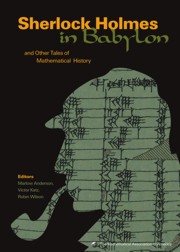Book contents
- Frontmatter
- Introduction
- Contents
- Ancient Mathematics
- Medieval and Renaissance Mathematics
- Foreword
- The Discovery of the Series Formula for π by Leibniz, Gregory and Nilakantha
- Ideas of Calculus in Islam and India
- Was Calculus Invented in India?
- An Early Iterative Method for the Determination of sin 1°
- Leonardo of Pisa and his Liber Quadratorum
- The Algorists vs. the Abacists: An Ancient Controversy on the Use of Calculators
- Sidelights on the Cardan-Tartaglia Controversy
- Reading Bombelli's χ-purgated Algebra
- The First Work on Mathematics Printed in the New World
- Afterword
- The Seventeenth Century
- The Eighteenth Century
- Index
- About the Editors
Leonardo of Pisa and his Liber Quadratorum
from Medieval and Renaissance Mathematics
- Frontmatter
- Introduction
- Contents
- Ancient Mathematics
- Medieval and Renaissance Mathematics
- Foreword
- The Discovery of the Series Formula for π by Leibniz, Gregory and Nilakantha
- Ideas of Calculus in Islam and India
- Was Calculus Invented in India?
- An Early Iterative Method for the Determination of sin 1°
- Leonardo of Pisa and his Liber Quadratorum
- The Algorists vs. the Abacists: An Ancient Controversy on the Use of Calculators
- Sidelights on the Cardan-Tartaglia Controversy
- Reading Bombelli's χ-purgated Algebra
- The First Work on Mathematics Printed in the New World
- Afterword
- The Seventeenth Century
- The Eighteenth Century
- Index
- About the Editors
Summary
The thirteenth century is a period of great fascination for the historian, whether his chief interest is in political, social, or intellectual movements. During this century great and far-reaching changes were taking place in all lines of human activity. It was the century in which culminated the long struggle between the Papacy and the Empire; it brought the beginnings of civil liberty in England; it saw the building of the great Gothic cathedrals, and the establishment and rapid growth of universities in Paris, Bologna, Naples, Oxford, and many other centers. The crusades had awakened the European peoples out of their lethargy of previous centuries, and had brought them face to face with the more advanced intellectual development of the East. Countless travelers passed back and forth between Italy and Egypt, Asia Minor, Syria, and Bagdad; and not a few adventurous and enterprising spirits dared to penetrate as far as India and China. The name of Marco Polo will occur to everyone, and he is only the most famous among many who in those stirring days truly discovered new worlds.
Among the many valuable gifts which the Orient transmitted to the Occident at this time, undoubtedly the most precious was its scientific knowledge, and in particular the Arabian and Hindu mathematics. The transfer of knowledge and ideas from East to West is one of the most interesting phenomena of this interesting period, and accordingly it is worth while to consider the work of one of the pioneers in this movement.
- Type
- Chapter
- Information
- Sherlock Holmes in BabylonAnd Other Tales of Mathematical History, pp. 143 - 147Publisher: Mathematical Association of AmericaPrint publication year: 2003



